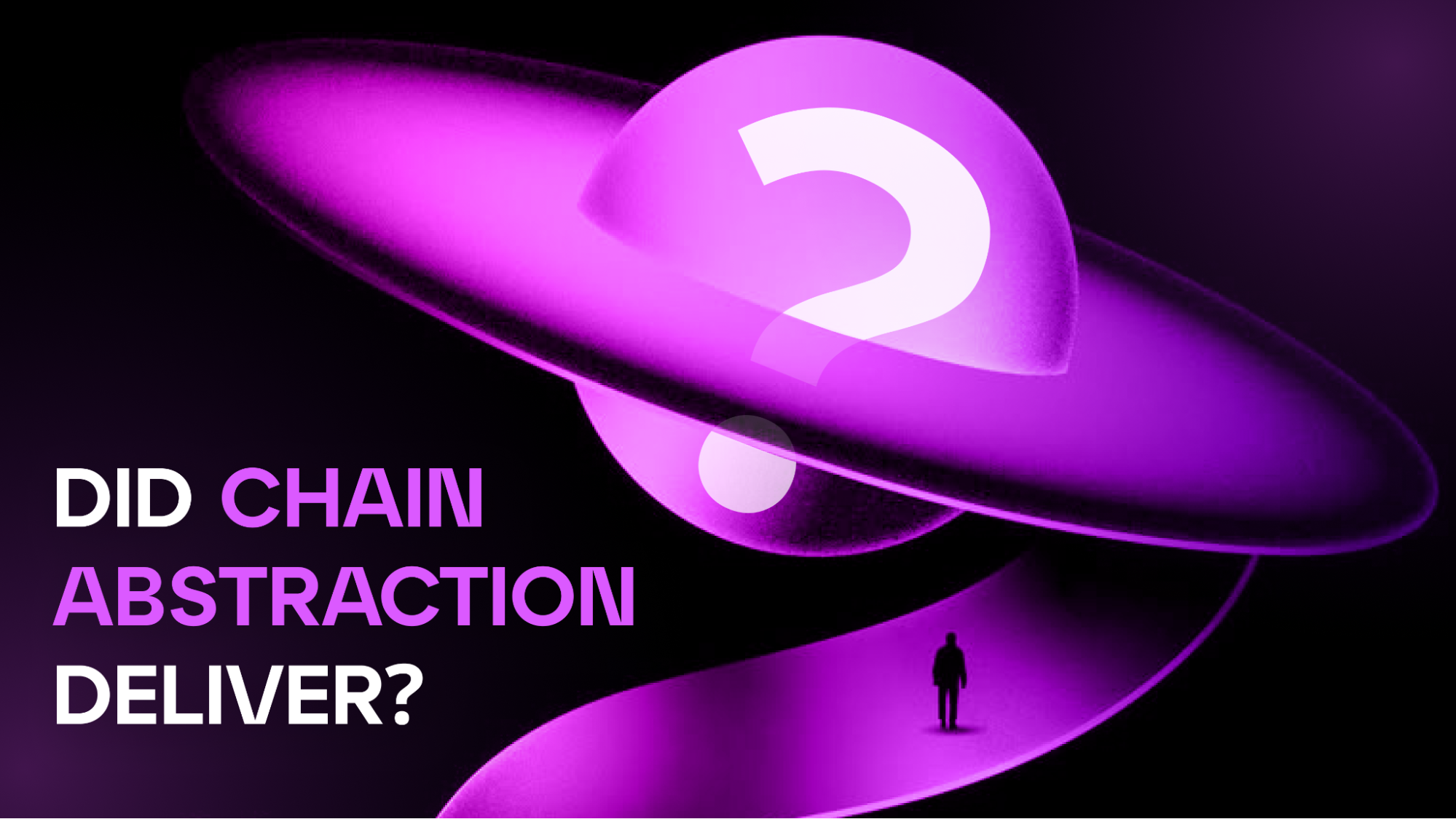State of Chain Abstraction: Is ChA still relevant in June 2025?

Table of Contents:
We went all-in for chain abstraction (ChA) in early 2024.
Back then, we had an ambitious yet clear goal: creating a Web3 experience where the notion of multiple blockchains is fully invisible to users.
Two years later, we can say with certainty that we put ChA on the industry’s radar and turned it into a Web3 cultural movement. In a provocative (but never unrealistic) style, we transformed the conversation from interoperability and infrastructure to user experience and consumer products.
But after a year, it’s only fair to ask: Has the ChA vision held up?
Foundations: Checking our thesis
Let’s start with the base problem ChA aims to solve: fragmentation.
All the data indicates that Web3’s fragmentation problem wasn’t just confirmed: in fact, it grew. We won’t spoil anything from our upcoming 2025 Web3 fragmentation report yet, but three factors point to fragmentation becoming an even greater problem.
Factor #1: More chains
Developer tooling has made it exponentially easier to launch bespoke L1s and L2s.
Hundreds of rollups launched in 2024 alone, and the growth curve has steepened in 2025, with every major “modular” framework showing 2‑6× chain‑count growth since 2023. Furthermore, the roadmap of certain ecosystems, like Polygon’s AggLayer and Optimism’s Superchain, relies heavily on the interconnection of a stack of multiple chains.
The exact number of chains in existence is difficult to quantify, as many are in early-stage development phases, operating under the radar, or used only privately. However, the following numbers paint the picture of this fragmentation and ongoing expansion:
- Optimism’s expanding Superchain ecosystem has grown to encompass 30+ chains.
- At least 159 Ethereum rollups are fully operational.
- There are 25 Avalanche L1s.
- The IBC ecosystem features over 120 blockchains, and Polkadot encompasses more than 60 appchains.
- Sites like DeFiLlama track the TVL of up to 396 blockchains.

“But wait!” you say, “just because there are more chains, that doesn’t mean that’s necessarily a problem.”We hear you loud and clear. Let’s next examine whether users still find it difficult to navigate an ever-complex ecosystem.
Factor #2: You’re bridging more, and more, and more
An undeniable factor is that, when done manually and not as a part of an abstracted journey, bridging is a pain point for users. And, as the chart below illustrates, over the last year, the industry has grown to rely more and more on bridging:

As the chart shows, bridge usage is generally experiencing growth: cross-chain bridge volume reached $17.3B in May, up 30% month-over-month as users hop between isolated liquidity pools. Perhaps more impressively, from the bridging era’s bottom (Jan 23) to its peak (Jan 25), bridging volume has more than 10x’d.
Although this data isn’t conclusive—there is, after all, no way to know whether most bridging is manual or automated—the lack of chain-agnostic applications, alongside bridging’s growth, does point to an increase in fragmentation.
Furthermore, two additional factors suggest that bridges remain an inconvenience factor:
- A lingering dominance of native bridges, which are rarely used in automation.
- The concentration of bridging volume across 3-6 bridges at any given time, suggesting their usage solely to adapt to market conditions/opportunities amidst fragmentation. In other words, money flows where money is—and will easily and quickly flock anywhere.

Factor #3: The industry’s OGs are still calling for it
Let’s, lastly, hear what the experts have to say.
Chain abstraction is widely recognized as an ecosystem need by its leaders. As a problem that can (and should) be addressed from many different perspectives, fragmentation affects everyone equally, and different players have different ideas on how to tackle it.
Two quotes underscore this:
Vitalik Buterin (Ethereum co-founder): “Our biggest UX problem is that the L2-verse doesn't feel enough like a unified Ethereum.”
Anatoly Yakovenko (Solana co-founder): “There should be a meta blockchain. Post data anywhere, such as Ethereum, Celestia, or Solana, and use a specific rule to merge data from all the chains into a single ordering.”
The writing’s on the wall: For the decentralized Web to be a Web in a legitimate sense, chain abstraction is mandatory. The ways to get there may vary, but the vision stays the same.
But, is ChA being delivered?
Throughout 2024, chain abstraction resonated with the industry to the point where, for a while, everyone seemed to be talking about it in one way or another.
The story then unfolded in pure crypto fashion: a Cambrian explosion of creativity emerged around the “narrative,” which then died down as a keyword (CT’s attention span is, after all, short), but never as a vision.

This correction in mindshare is, in part, positive for chain abstraction: As grifters pivot and unserious builders fizzle out, many are still delivering. Furthermore, in an industry accustomed to huge expectations that often fail to materialize, incremental progress is often dismissed… until it becomes too big to ignore.
Here, we want to highlight four projects that have managed to make an impact:
Arcana Network
Arcana has recently deployed Arcana Auth v2 and rolled out its embedded Chain-Abstracted Wallet SDK. This SDK demonstrates that ChA can be embedded invisibly within Web 2-style onboarding flows. It also features a polished design showcasing the combination of users’ assets across chains.
Arcana’s SDK is currently primarily used within its own Arcana Wallet, with a ChA implementation currently focused on EVM chains only. Its public SDKs are still in the process of getting traction within external dApps.

OneBalance
OneBalance has also debuted its “Credible Accounts” API, which lets any project surface a single balance across 15+ chains. This API, which is currently used by two games and a pay‑roll app, is a part of their broader development tools, integrating with Wallet-as-a-Service applications for streamlined onboarding.
Furthermore, OneBalance has also delivered OneApp, a swapping protocol built leveraging Credible Accounts’ aggregation. Its chain abstraction protocol is mostly leveraged by this app, and integrated Bitcoin alongside EVM chains.

DeFi.app
The project attempting to create an “everything app” for crypto has also implemented their own take on chain abstraction. Their application features a familiar flow combining assets from multiple chains—albeit with a more complex deposit interface.
DeFi.app currently features swaps and perpetuals trading. Ultimately, it aims to integrate with every single decentralized finance product, transforming it into a DeFi powerhouse powered by ChA. Unlike the previous two builders, DeFi.app doesn’t aim to turn its solutions into infrastructure, but rather utilize them within their own dApp only.
Particle Network—of course
From our trench, we continue to build to get ChA delivered and adopted. As a sample of this:
- Over 90 projects are on their way to integrating Universal Accounts, with the first cohort going live a couple of months ago.
- UniversalX, the first chain-agnostic app and leading chain-abstracted trading platform, is driving millions of dollars in daily volume, poised to become the overall fastest trading platform in the market, and… REDACTED.
- Universal Accounts’ adoption rose to 110,900 (+558 % QoQ) in Q1 2025, and the growth rate has stayed above 30% monthly since. And, in case you don’t notice it in the chart below, we’re still accelerating.

To contextualize these metrics, it’s important to remember that Universal Accounts are not publicly available or permissionless yet. Over the next months, Particle Network will collaborate with a select number of projects to create a chain-abstracted proprietary ecosystem, and then enable anyone to deploy them to chain-abstract their project.
UniversalX’s expansion due to REDACTED will also play a critical role in chain-abstracting the Web3 ecosystem, setting a precedent for how, once you go abstract, you can never go back.
Normalizing chain abstraction
So yes, chain abstraction is is already sneaking into Web3, going to great lengths. And yet, all of this has happened under sub-ideal circumstances.
As shown by the success of ERC-4337, the industry standard for smart accounts, Web3 continues to push forward and advance faster by innovating upon hard-to-update infrastructure. As the market’s demands become clear, this infrastructure then advances and becomes enshrined to guarantee a better user experience.
In fact, there are several upgrades on the horizon for chain abstraction, such as:
- Ethereum’s Pectra upgrade (EIP-7702): While technically done, we still haven’t seen the results of this upgrade start to come to life. 7702 allows regular EOAs (accounts such as your MetaMask) run code per tx. This enables gas sponsorships, batching, and delegation natively, vastly improving wallet UX and upgrading account abstraction on Ethereum. For chain abstraction and Universal Accounts, this means that we can now include users’ existing wallets into the abstracted flow, without the need for them to manually migrate into Universal Accounts. A game-changer.
- Intent standards for Ethereum (ERC-7683): Several success stories have highlighted the importance of intent-centric design to create desirable Web3 apps—and intent-based cross-chain transactions are chief amongst them. The enshrining of an intents standard would facilitate the adoption of these, which in turn would spread native ChA within the ecosystem.
- Broader implementations of blockchain-level chain abstraction: Albeit more chains does result in greater fragmentation, having rollup and subnet ecosystems become truly intrinsically interoperable opens the door for better, simpler unification standards across the industry.
To conclude…
There are three lessons we can learn from looking back on ChA’s last year:
Lesson #1: The thesis holds. As long as there are more than two chains, fragmentation is an endemic UX tax. Chain abstraction fixes it and makes for better apps.
Lesson #2: Shipping beats storytelling. Quiet builders have advanced the state of the art while louder brands rebranded away. And, adopter by adopter, these efforts will spread ChA like a virus.
Lesson #3: Standards matter. Upgrades like EIP‑7702 and chain-abstracted ecosystems will accelerate the efforts of any project facilitating ChA beyond their own efforts. Meanwhile, we build, together.
Chain abstraction is already live, but the work is not done. Fortunately, technological innovation will accompany the current pragmatic approach to enabling it.
Enjoy the dApps.
Particle Network's Chain Abstraction solutions are 100% free for developers and teams. By integrating them, you can set your project in a path to leveraging chain abstraction.
About Particle Network

Particle Network powers chain abstraction, addressing Web3's fragmentation of users and liquidity. This is enabled by Particle's Universal Accounts, which give users a unified account and balance across all chains.
Share this article
About the author(s)


